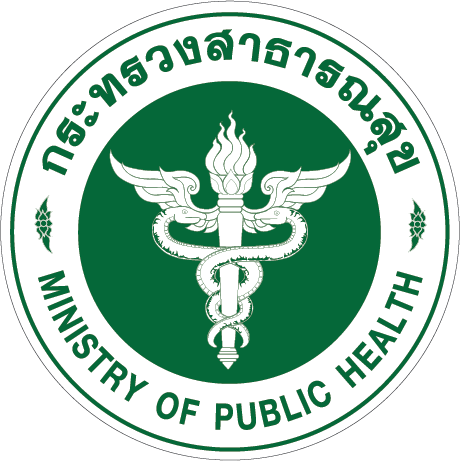Amount of Prescribing of Injectable Antibacterial Drugs in Defined Daily Dose (DDD) in Inpatients at Chaiyaphum Hospital
Keywords:
injectable antibacterial drugs, defined daily dose, antimicrobial resistanceAbstract
Background The problem of drug resistance is an important medical problem in Thailand because it causes many negative effects both in terms of treatment results and expenditure. There is evidence from studies showing that overuse of antibiotics is a contributing factor to many bacterial resistance problems.
Objectives To analyze the value and consumption of injectable antibacterial drug in the form of defined daily dose (DDD), separated by types and groups of antibacterial drugs available at Chaiyaphum hospital during the fiscal year 2020-2022
Method This descriptive was conducted by retrieving data on antibacterial drug prescribing in inpatients at Chaiyaphum Hospital from the HOSXP database and the RDUR9 version 62.10.01 program, Health Region 9 was used to analyze DDD and calculate the value of drugs prescribed from the purchase price each year. Data were analyzed statistically by frequency and percentage.
Results The total values of prescribed injectable antibacterial drugs in the fiscal year 2020-2022 were 89,915,896 baht, classified by each fiscal year equal to 23,852,171 baht, 31,288,166 baht and 34,775,559 baht, respectively. The first three highest values of drug group were carbapenems 28,509,463 baht (31.71%), beta-lactam/betalactamase inhibitors (BLBI) 18,336,532 baht (20.39%) and phosphonic acids 9,822,641 baht (10.92%). The top three highest values of drugs were meropenem 23,470,713 baht (26.10%), fosfomycin 9,822,641 baht (10.92%) and piperacillin-tazobactam 7,926,480 baht (8.82%). The total values of prescribing increased by an average of 18.22% per year. The total DDD during the three fiscal years was 333.08, classified by each fiscal year equal to 117.84, 111.66 and 103.58, respectively which decreased by an average of 6.42% per year. The first three groups with the highest DDD were 3rd generation cephalosporins (100.11), carbapenems (48.81) and BLBI (35.78). The top three drugs with the highest DDD were ceftriaxone (65.32), meropenem (46.70) and ceftazidime (30.84).
Conclusions The value of prescribed injectable antibacterial drugs in inpatients tended to increase, especially carbapenem group but the total DDD tended to decrease.
References
Singh P, Gupta DK, Bindra A, Trikha A, Lathwal A, Malhotra R, et al. Antimicrobial consumption in intensive care unit patients at level 1 trauma centre in India. Indian J Med Microbiol. 2022;40(1):86-90.
กระทรวงสาธารณสุข. แผนยุทธศาสตร์การจัดการการดื้อยาต้านจุลชีพประเทศไทย พ.ศ. 2560–2564. กรุงเทพมหานคร: กระทรวงสาธารณสุข; 2559.
Junkunapas P, Bunyarit P, Prapasoe N, Sreesupan W, Leungreungrong P. AMR hospital management guideline. Nonthaburi: Health Administration Division; 2016.
อนุวัฒน์ สุรินราช, อนุศักดิ์ เกิดสิน, ประภัสสร สมศรี. ปัจจัยเสี่ยงต่อการติดเชื้อแบคทีเรียดื้อยาคาร์บาพีเนมในผู้ป่วยโรคหลอดเลือดสมอง โรงพยาบาลสกลนคร. วารสารโรงพยาบาลสกลนคร. 2562;22(1):40-51.
อารยา ข้อค้า. ยาปฏิชีวนะและการดื้อยาปฏิชีวนะของแบคทีเรีย. วารสารการแพทย์และวิทยาศาสตร์สุขภาพ. 2563;27(2):125-139.
Bansal D, Mangla S, Undela K, Gudala K, D'Cruz S, Sachdev A, et al. Measurement of adult antimicrobial drug use in tertiary care hospital using defined daily dose and days of therapy. Indian J Pharm Sci. 2014;76(3):211-7.
Sözen H, Gönen I, Sözen A, Kutlucan A, Kalemci S, Sahan M. Application of ATC/DDD methodology to evaluate of antibiotic use in a general hospital in Turkey. Ann Clin Microbiol Antimicrob. 2013;12:23. doi: 10.1186/1476-0711-12-23.
Muller A, Monnet DL, Talon D, Hénon T, Bertrand X. Discrepancies between prescribed daily doses and WHO defined daily doses of antibacterials at a university hospital. Br J Clin Pharmacol. 2006;61(5):585-91. doi: 10.1111/j.1365-2125.2006.02605.x.
กระทรวงสาธารณสุข. กรมการแพทย์. คู่มือการประเมินการจัดการการดื้อยาต้านจุลชีพอย่างบูรณาการในโรงพยาบาล. กรุงเทพมหานคร: งานพิมพ์; 2565.
WHO Collaborating Centre for Drug Statistics Methodology. ATC/DDD index [Internet]. Oslo, Norway: World Health Organization; [cited 2022 Dec 1]. Available from: https://www.whocc.no/atc_ddd_index/
WHO Collaborating Centre for Drug Statistics Methodology. Guidelines for ATC classification and DDD assignment 2022 [Internet]. Oslo, Norway: World Health Organization; 2022 [cited 2022 Nov.10]. Available from: https://www.whocc.no/atc_ddd_index_and_guidelines/guidelines/
ไพบูลย์ พิทยาเธียรอนันต์, สุทธิพงษ์ เดชก้อง และ จีริสุดา ฉวีรักษ์. ปริมาณและมูลค่าการสั่งใช้ยาต้านแบคทีเรียชนิดฉีดในแผนกผู้ป่วยในโรงพยาบาลราชวิถี. วารสารกรมการแพทย์. 2564;46(1):117-26
Tarun S, Kapil S, Amit N, Gaurav J, Munawwar H, Gurvinder S, et al. Assessment of antimicrobial drugs utilization in tertiary care hospital - an antimicrobial stewardship implication. IJHS. 2022;6(S7):5474–83. Available from: https://sciencescholar.us/journal/index.php/ijhs/article/view/13258 https://doi.org/10.53730/ijhs.v6nS7.13258
ชุติมาภรณ์ ไชยสงค์, สมพิศ ปินะเก, สุรศักดิ์ ไชยสงค์, พิริยา ติยาภักดิ์. ความสัมพันธ์ของปริมาณการใช้ยาและการดื้อยาปฏิชีวนะในโรงพยาบาลมหาสารคาม. วารสารเภสัชศาสตร์อีสาน. 2562;15(2):98-105
โรงพยาบาลชัยภูมิ. กลุ่มงานเทคนิคการแพทย์. ข้อมูลเชื้อดื้อยาในกระแสเลือดโรงพยาบาลชัยภูมิ ปีงบประมาณ 2563-2565. ชัยภูมิ: โรงพยาบาลชัยภูมิ; 2565.
สำนักข่าว Hfocus เจาะลึกระบบสุขภาพ. ใช้ยาปฏิชีวนะสมเหตุสมผลลดปัญหาเชื้อดื้อยา [อินเทอร์เน็ต]. กรุงเทพมหานคร: 2560 [สืบค้นเมื่อ 15 พ.ย.2565 ]. สืบค้นจาก: https://www.hfocus.org/content/2017/11/14839

Downloads
Published
How to Cite
Issue
Section
License
Copyright (c) 2023 Health Administration Division, Office of the Permanent Secretary, Ministry of Public Health and The Society of Hospital Pharmacist, Ministry of Public Health

This work is licensed under a Creative Commons Attribution-NonCommercial-NoDerivatives 4.0 International License.
ข้อความภายในบทความที่ตีพิมพ์ในวารสารเภสัชกรรมคลินิกทั้งหมด รวมถึงรูปภาพประกอบ ตาราง เป็นลิขสิทธิ์ของกองบริหารการสาธารณสุข สำนักงานปลัดกระทรวงสาธารณสุข และ ชมรมเภสัชกรโรงพยาบาลกระทรวงสาธารณสุข การนำเนื้อหา ข้อความหรือข้อคิดเห็น รูปภาพ ตาราง ของบทความไปจัดพิมพ์เผยแพร่ในรูปแบบต่าง ๆ เพื่อใช้ประโยชน์ในเชิงพาณิชย์ ต้องได้รับอนุญาตจากกองบรรณาธิการวารสารเภสัชกรรมคลินิกอย่างเป็นลายลักษณ์อักษร
กองบริหารการสาธารณสุข สำนักงานปลัดกระทรวงสาธารณสุข และ ชมรมเภสัชกรโรงพยาบาลกระทรวงสาธารณสุข อนุญาตให้สามารถนำไฟล์บทความไปใช้ประโยชน์และเผยแพร่ต่อได้ โดยอยู่ภายใต้เงื่อนไขสัญญาอนุญาตครีเอทีฟคอมมอน (Creative Commons License: CC) โดย ต้องแสดงที่มาจากวารสาร – ไม่ใช้เพื่อการค้า – ห้ามแก้ไขดัดแปลง, Attribution-NonCommercial-NoDerivatives 4.0 International (CC BY-NC-ND 4.0)
ข้อความที่ปรากฏในบทความในวารสารเป็นความคิดเห็นส่วนตัวของผู้เขียนแต่ละท่านไม่เกี่ยวข้องกับกองบริหารการสาธารณสุข สำนักงานปลัดกระทรวงสาธารณสุข และ ชมรมเภสัชกรโรงพยาบาลกระทรวงสาธารณสุข และบุคลากรในกองฯ หรือ ชมรมฯ แต่อย่างใด ความรับผิดชอบองค์ประกอบทั้งหมดของบทความแต่ละเรื่องเป็นของผู้เขียนแต่ละท่าน หากมีความผิดพลาดใด ๆ ผู้เขียนแต่ละท่านจะรับผิดชอบบทความของตนเอง ตลอดจนความรับผิดชอบด้านเนื้อหาและการตรวจร่างบทความเป็นของผู้เขียน ไม่เกี่ยวข้องกับกองบรรณาธิการ



